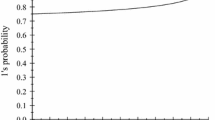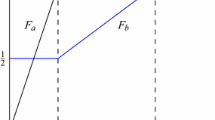Abstract
We study two-sided matching contests with two sets, each of which includes two heterogeneous players with commonly known types. The players in each set compete in all-pay contests where they simultaneously send their costly efforts and then are assortatively matched. A player has a value function that depends on his type as well as his matched one. This model always has a corner equilibrium in which the players do not exert efforts and are randomly matched. We characterize the interior equilibrium and show that although players exert costly (wasted) efforts, this equilibrium might be welfare superior to the corner equilibrium. We analyze the cross effects of the players’ types on the expected payoffs of the other players as well as on their effect on the players’ expected total effort, and demonstrate the complexity of these cross effects.
Similar content being viewed by others
Notes
Peters (2007) showed that equilibrium efforts in a very large finite two-sided matching model can be quite different from the equilibrium efforts in the continuum model.
Here we would require that the value functions be convex.
The effects of the types in set B on the total effort in set B are similar.
If the value functions are convex then this result according to which the assortative matching welfare superior to the random matching holds when the difference between the types in each set is sufficiently large even if the lower types in both sets do not approach zero.
References
Akerlof RJ, Holden RT (2012) The nature of tournaments. Econ Theor 51:289–313
Baye M, Hoppe H (2003) The strategic equivalence of rent-seeking, innovation, and patent-race games. Games Econ Behav 44(2):217–226
Baye M, Kovenock D, de Vries C (1993) Rigging the lobbying process: an application of the all-pay auction. Am Econ Rev 83:289–294
Baye M, Kovenock D, de Vries C (1996) The all-pay auction with complete information. Econ Theor 8:291–305
Bhaskar V, Hopkins E (2016) Marriage as a rat race: noisy pre-marital investments with assortative matching. J Polit Econ 124:992–1045
Booth A, Coles M (2010) Education, matching, and the allocative value of romance. J Eur Econ Assoc 8(4):744–775
Che YK, Gale I (1998) Caps on political lobbying. Am Econ Rev 88:643–651
Clark D, Riis C (1998) Contest success functions: an extension. Econ Theor 11:201–204
Cohen C, Rabi I, Sela A (2020) Assortative matching contests. Working paper
Dizdar D, Moldovanu B, Szech N (2019) The feedback marginal effect in two-sided markets with bilateral investments. J Econ Theory 182:106–142
Gall T, Hu X, Vlassopoulos M (2019) Dynamic incentive effects of assignment mechanisms: experimental evidence. J Econ Manag Strategy 28(4):687–712
Gallice A (2017) An approximate solution to rent-seeking contests with private information. Eur J Oper Res 256:673–684
Hillman A, Riley J (1989) Politically contestable rents and transfers. Econ Polit 1:17–39
Hillman A, Samet D (1987) Dissipation of contestable rents by small numbers of contenders. Public Choice 54(1):63–82
Hoppe H, Moldovanu B, Sela A (2009) The theory of assortative matching based on costly signals. Rev Econ Stud 76(1):253–281
Hoppe H, Moldovanu B, Ozdenoren E (2011) Coarse matching with incomplete information. Econ Theor 47(1):75–104
Lazear E, Rosen S (1981) Rank-order tournaments as optimum labor contracts. J Polit Econ 89:841–864
McAfee RP (2002) Coarse matching. Econometrica 70:2025–2034
Moldovanu B, Sela A (2001) The optimal allocation of prizes in contests. Am Econ Rev 91:542–558
Moldovanu B, Sela A (2006) Contest architecture. J Econ Theory 126:70–96
Odegaard F, Anderson CK (2014) All-pay auctions with pre-and post-bidding options. Eur J Oper Res 239(2):579–592
Pesendorfer W (1995) Design innovations and fashion cycles. Am Econ Rev 85:771–792
Peters M (2007) The pre-marital investments game. J Econ Theory 137:186–213
Rosen S (1986) Prizes and incentives in elimination tournaments. Am Econ Rev 76:701–715
Siegel R (2009) All-pay contests. Econometrica 77(1):71–92
Skaperdas S (1996) Contest success functions. Econ Theor 7:283–290
Spence M (1973) Job market signaling. Q J Econ 87:296–332
Tullock G (1980) Efficient rent-seeking. In: Buchanan JM, Tollison RD, Tullock G (eds) Toward a theory of rent-seeking society. Texas A. &M. University Press, College Station
Author information
Authors and Affiliations
Corresponding author
Additional information
Publisher's Note
Springer Nature remains neutral with regard to jurisdictional claims in published maps and institutional affiliations.
Appendix
Appendix
1.1 Proof of Proposition 2
By (5), player \(a_{1}\)’s probability of winning in set A is
By Condition (1), \((f(a_{1},b_{1})-f(a_{1},b_{2}))\) strictly increases in \(a_{1}\) , which implies that \(\frac{dp_{1}^{a}}{da_{1}} >0\), or, alternatively, \(\frac{dp_{2}^{a}}{da_{1}}<0\). Similarly, \(f(a_{2},b_{1})-f(a_{2},b_{2})\) strictly decreases in \(a_{2}\), which implies that \(\frac{dp_{1}^{a}}{da_{2}}<0\) or, alternatively, \(\frac{dp_{2}^{a}}{ da_{2}}>0.\)
1) By (5),
Thus, \(\frac{dp_{1}^{a}}{db_{1}}\ge 0\), or \(\frac{dp_{2}^{a}}{db_{1}}\le 0\) iff \(f_{b}(a_{1}b_{1})(f(a_{2},b_{1})-f(a_{2},b_{2}))-f_{b}(a_{2},b_{1})(f(a_{1},b_{1})-f(a_{1},b_{2}))\ge 0.\)
2) Similarly,
Thus, \(\frac{dp_{1}^{a}}{db_{2}}\ge 0\), or \(\frac{dp_{2}^{a}}{db_{2}}\le 0\) iff \(f_{b}(a_{2},b_{2})(f(a_{1},b_{1})-f(a_{1},b_{2}))-f_{b}(a_{1}b_{2})(f(a_{2},b_{1})-f(a_{2},b_{2}))\ge 0.\) Likewise, we can obtain similar results for the players’ probabilities in set B. \(\square\)
1.2 Proof of Proposition 3
By (4), player \(a_{1}\)’s expected payoff is
Thus,
Since \(\frac{dp_{1}^{b}}{da_{1}}=-\frac{dp_{2}^{b}}{da_{1}}\) we have
We obtain that if \(\frac{dp_{1}^{b}}{da_{1}}=0\), then \(\frac{du_{1}^{a}}{ da_{1}}>0.\)
(2) Likewise,
Since \((p_{2}^{b}-p_{1}^{b})<0\), by Condition (1) we obtain that \((f_{a}(a_{2},b_{1})-f_{a}(a_{2},b_{2})+f_{a}(a_{2},b_{2}))(p_{2}^{b}-p_{1}^{b})<0.\) Thus, if \(\frac{dp_{1}^{b}}{da_{2}}=0\), then \(\frac{du_{1}^{a}}{da_{2}}<0.\)
(3) By (3), player \(a_{2}\)’s expected payoffs
Then,
Thus, if \(\frac{dp_{2}^{b}}{da_{1}}=0\), then \(\frac{du_{2}^{a}}{da_{1}}=0.\)
(4) Last,
Since by Condition 1\((f_{a}(a_{2},b_{1})-f_{a}(a_{2},b_{2}))>0\), we obtain that if \(\frac{ dp_{2}^{b}}{da_{2}}=0_{,}\) then \(\frac{du_{2}^{a}}{da_{2}}>0.\) Likewise, we can obtain similar results on the players’ expected payoffs in set B. \(\square\)
1.3 Proof of Proposition 4
(1) By (13), the players’ expected total effort in set A is
Then,
By (17), we have that \(\frac{dp_{1}^{b}}{da_{1}}\le 0\) iff
and by Condition 1 we have
Thus, if Condition (17) is satisfied, we obtain that \(\frac{ dTE_{A}}{da_{1}}<0.\)
(2) By (13),
By (18), \(\frac{dp_{2}^{b}}{da_{2}}\le 0\) iff
and by Condition 1 we have
Thus, if Condition (18) is satisfied, we obtain that \(\frac{ dTE_{A}}{da_{2}}>0\). \(\square\)
1.4 Proof of Proposition 5
By (20), the welfare in the assortative matching contest is
Assume that the lower types in both sets approach zero. Then, by (5) and (8)
Then,
On the other hand, by (21),
Thus,
Now, assume that the difference between the lower type and the higher type in each set approaches zero. Then by (5) and (8) we have
and therefore, by (13) and (14),
Thus, we obtain that
\(\square\)
Rights and permissions
Springer Nature or its licensor (e.g. a society or other partner) holds exclusive rights to this article under a publishing agreement with the author(s) or other rightsholder(s); author self-archiving of the accepted manuscript version of this article is solely governed by the terms of such publishing agreement and applicable law.
About this article
Cite this article
Sela, A. All-pay matching contests. Int J Game Theory 52, 587–606 (2023). https://doi.org/10.1007/s00182-022-00831-2
Accepted:
Published:
Issue Date:
DOI: https://doi.org/10.1007/s00182-022-00831-2




